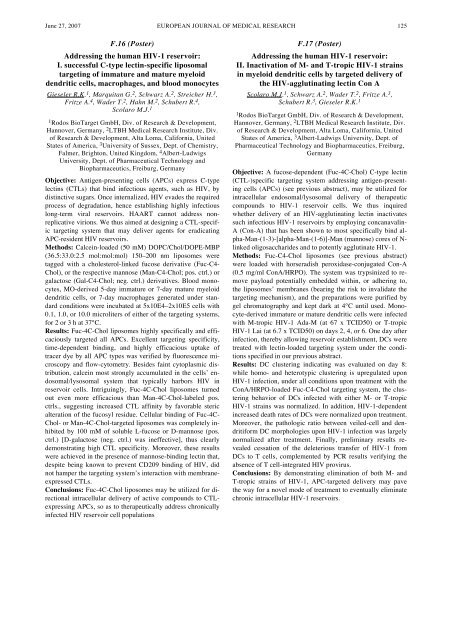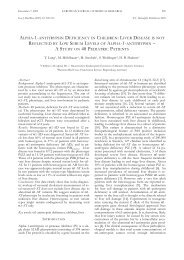European Journal of Medical Research - Deutsche AIDS ...
European Journal of Medical Research - Deutsche AIDS ...
European Journal of Medical Research - Deutsche AIDS ...
Create successful ePaper yourself
Turn your PDF publications into a flip-book with our unique Google optimized e-Paper software.
June 27, 2007 EUROPEAN JOURNAL OF MEDICAL RESEARCH<br />
125<br />
F.16 (Poster)<br />
Addressing the human HIV-1 reservoir:<br />
I. successful C-type lectin-specific liposomal<br />
targeting <strong>of</strong> immature and mature myeloid<br />
dendritic cells, macrophages, and blood monocytes<br />
Gieseler R.K. 1 , Marquitan G. 2 , Schwarz A. 2 , Streicher H. 3 ,<br />
Fritze A. 4 , Wader T. 2 , Hahn M. 2 , Schubert R. 4 ,<br />
Scolaro M.J. 1<br />
1 Rodos BioTarget GmbH, Div. <strong>of</strong> <strong>Research</strong> & Development,<br />
Hannover, Germany, 2 LTBH <strong>Medical</strong> <strong>Research</strong> Institute, Div.<br />
<strong>of</strong> <strong>Research</strong> & Development, Alta Loma, California, United<br />
States <strong>of</strong> America, 3 University <strong>of</strong> Sussex, Dept. <strong>of</strong> Chemistry,<br />
Falmer, Brighton, United Kingdom, 4 Albert-Ludwigs<br />
University, Dept. <strong>of</strong> Pharmaceutical Technology and<br />
Biopharmaceutics, Freiburg, Germany<br />
Objective: Antigen-presenting cells (APCs) express C-type<br />
lectins (CTLs) that bind infectious agents, such as HIV, by<br />
distinctive sugars. Once internalized, HIV evades the required<br />
process <strong>of</strong> degradation, hence establishing highly infectious<br />
long-term viral reservoirs. HAART cannot address nonreplicative<br />
virions. We thus aimed at designing a CTL-specific<br />
targeting system that may deliver agents for eradicating<br />
APC-resident HIV reservoirs.<br />
Methods: Calcein-loaded (50 mM) DOPC/Chol/DOPE-MBP<br />
(36.5:33.0:2.5 mol:mol:mol) 150–200 nm liposomes were<br />
tagged with a cholesterol-linked fucose derivative (Fuc-C4-<br />
Chol), or the respective mannose (Man-C4-Chol; pos. ctrl.) or<br />
galactose (Gal-C4-Chol; neg. ctrl.) derivatives. Blood monocytes,<br />
MO-derived 5-day immature or 7-day mature myeloid<br />
dendritic cells, or 7-day macrophages generated under standard<br />
conditions were incubated at 5x10E4–2x10E5 cells with<br />
0.1, 1.0, or 10.0 microliters <strong>of</strong> either <strong>of</strong> the targeting systems,<br />
for 2 or 3 h at 37°C.<br />
Results: Fuc-4C-Chol liposomes highly specifically and efficaciously<br />
targeted all APCs. Excellent targeting specificity,<br />
time-dependent binding, and highly efficacious uptake <strong>of</strong><br />
tracer dye by all APC types was verified by fluorescence microscopy<br />
and flow-cytometry. Besides faint cytoplasmic distribution,<br />
calcein most strongly accumulated in the cells’ endosomal/lysosomal<br />
system that typically harbors HIV in<br />
reservoir cells. Intriguingly, Fuc-4C-Chol liposomes turned<br />
out even more efficacious than Man-4C-Chol-labeled pos.<br />
ctrls., suggesting increased CTL affinity by favorable steric<br />
alteration <strong>of</strong> the fucosyl residue. Cellular binding <strong>of</strong> Fuc-4C-<br />
Chol- or Man-4C-Chol-targeted liposomes was completely inhibited<br />
by 100 mM <strong>of</strong> soluble L-fucose or D-mannose (pos.<br />
ctrl.) [D-galactose (neg. ctrl.) was ineffective], thus clearly<br />
demonstrating high CTL specificity. Moreover, these results<br />
were achieved in the presence <strong>of</strong> mannose-binding lectin that,<br />
despite being known to prevent CD209 binding <strong>of</strong> HIV, did<br />
not hamper the targeting system’s interaction with membraneexpressed<br />
CTLs.<br />
Conclusions: Fuc-4C-Chol liposomes may be utilized for directional<br />
intracellular delivery <strong>of</strong> active compounds to CTLexpressing<br />
APCs, so as to therapeutically address chronically<br />
infected HIV reservoir cell populations<br />
F.17 (Poster)<br />
Addressing the human HIV-1 reservoir:<br />
II. Inactivation <strong>of</strong> M- and T-tropic HIV-1 strains<br />
in myeloid dendritic cells by targeted delivery <strong>of</strong><br />
the HIV-agglutinating lectin Con A<br />
Scolaro M.J. 1 , Schwarz A. 2 , Wader T. 2 , Fritze A. 3 ,<br />
Schubert R. 3 , Gieseler R.K. 1<br />
1 Rodos BioTarget GmbH, Div. <strong>of</strong> <strong>Research</strong> & Development,<br />
Hannover, Germany, 2 LTBH <strong>Medical</strong> <strong>Research</strong> Institute, Div.<br />
<strong>of</strong> <strong>Research</strong> & Development, Alta Loma, California, United<br />
States <strong>of</strong> America, 3 Albert-Ludwigs University, Dept. <strong>of</strong><br />
Pharmaceutical Technology and Biopharmaceutics, Freiburg,<br />
Germany<br />
Objective: A fucose-dependent (Fuc-4C-Chol) C-type lectin<br />
(CTL-)specific targeting system addressing antigen-presenting<br />
cells (APCs) (see previous abstract), may be utilized for<br />
intracellular endosomal/lysosomal delivery <strong>of</strong> therapeutic<br />
compounds to HIV-1 reservoir cells. We thus inquired<br />
whether delivery <strong>of</strong> an HIV-agglutinating lectin inactivates<br />
such infectious HIV-1 reservoirs by employing concanavalin-<br />
A (Con-A) that has been shown to most specifically bind alpha-Man-(1-3)-[alpha-Man-(1-6)]-Man<br />
(mannose) cores <strong>of</strong> N-<br />
linked oligosaccharides and to potently agglutinate HIV-1.<br />
Methods: Fuc-C4-Chol liposomes (see previous abstract)<br />
were loaded with horseradish peroxidase-conjugated Con-A<br />
(0.5 mg/ml ConA/HRPO). The system was trypsinized to remove<br />
payload potentially embedded within, or adhering to,<br />
the liposomes’ membranes (bearing the risk to invalidate the<br />
targeting mechanism), and the preparations were purified by<br />
gel chromatography and kept dark at 4°C until used. Monocyte-derived<br />
immature or mature dendritic cells were infected<br />
with M-tropic HIV-1 Ada-M (at 67 x TCID50) or T-tropic<br />
HIV-1 Lai (at 6.7 x TCID50) on days 2, 4, or 6. One day after<br />
infection, thereby allowing reservoir establishment, DCs were<br />
treated with lectin-loaded targeting system under the conditions<br />
specified in our previous abstract.<br />
Results: DC clustering indicating was evaluated on day 8:<br />
while homo- and heterotypic clustering is upregulated upon<br />
HIV-1 infection, under all conditions upon treatment with the<br />
ConA/HRPO-loaded Fuc-C4-Chol targeting system, the clustering<br />
behavior <strong>of</strong> DCs infected with either M- or T-tropic<br />
HIV-1 strains was normalized. In addition, HIV-1-dependent<br />
increased death rates <strong>of</strong> DCs were normalized upon treatment.<br />
Moreover, the pathologic ratio between veiled-cell and dendritiform<br />
DC morphologies upon HIV-1 infection was largely<br />
normalized after treatment. Finally, preliminary results revealed<br />
cessation <strong>of</strong> the deleterious transfer <strong>of</strong> HIV-1 from<br />
DCs to T cells, complemented by PCR results verifying the<br />
absence <strong>of</strong> T cell-integrated HIV provirus.<br />
Conclusions: By demonstrating elimination <strong>of</strong> both M- and<br />
T-tropic strains <strong>of</strong> HIV-1, APC-targeted delivery may pave<br />
the way for a novel mode <strong>of</strong> treatment to eventually eliminate<br />
chronic intracellular HIV-1 reservoirs.





